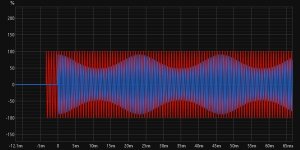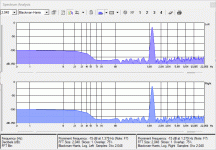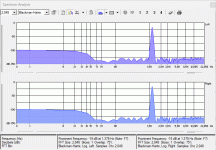I'm surprised that nobody has commented on the stupidity of this post.A cabinet that doesn't vibrate doesn't require vibrational isolation: hilariously circular argument.
If that's true then the standard audio tests would clearly reveal any differences. Whether tests of the wires or tests of the audio after passing through the wires. There is no magic with audio.I have been skeptical in the past of claims that cables could sound different, but more recently have heard some systems where cables do have some influence on the sound of a system.
Yes, my Null Tester video I already linked to.I suppose if I really wanted to know more about the vast number of cases I would have to go out in the field, visit some audiophile installations where cables are claimed to influence sound and do a little investigating. Maybe you have already done that?
On the above point I will have to disagree strongly. This is where it gets to the point where most of the people in audio need to have a better understanding of audio analyzers, how they work, what they are good for, and what they are weak at. Then we would be much better positioned to take on the remaining problems in audio: the things we aren't measuring well.If that's true then the standard audio tests would clearly reveal any differences.
Just as a very brief and limited example, the good and well educated folks at Purifi have a couple of sound files that can be listened to with headphones. The interesting thing about the two files is that they measure exactly the same in standard measurements yet they sound quite different. https://purifi-audio.com/blog/tech-notes-1/doppler-distortion-vs-imd-7
Unfortunately, the problems with standard measurements go considerably deeper than the Purifi example illustrates.
Last edited:
Do you need help understanding it? Feel free to reach out.I'm surprised that nobody has commented on the stupidity of this post.
I'm surprised that nobody has commented on the stupidity of this post.
I thot it was pretty good.
Where are the waterfalls you previously showed but in periods?
dave
Just as a very brief and limited example, the good and well educated folks at Purifi have a couple of sound files that can be listened to with headphones. The interesting thing about the two files is that they measure exactly the same in standard measurements yet they sound quite different. https://purifi-audio.com/blog/tech-notes-1/doppler-distortion-vs-imd-7
As I said earlier, there is no magic with audio. I downloaded both of the files (right-click the players then Save As), and the files do not "measure" the same. The FFT display in Sound Forge clearly shows the difference.
Try again?😛
What does it show, the files were checked before, then taken down and put back up?
Basically, each file should consist of 4 frequencies, with each frequency being at a fixed amplitude. The only difference between the files should be the phases of two of the frequencies. Perhaps choice of windowing is producing some artifacts?
Basically, each file should consist of 4 frequencies, with each frequency being at a fixed amplitude. The only difference between the files should be the phases of two of the frequencies. Perhaps choice of windowing is producing some artifacts?
You have kind of proposed maybe a high school level, or at least an introductory form of the scientific method without getting into more advanced ideas/details such as, disproving the alternate hypothesis, the application of statistics, etc. OTOH, in university studies such as engineering, the curriculum is typically designed to eventually make the student into some kind of expert who is also trained in doing independent scientific research by the time the PhD level is achieved.
Also it turns out audio is a very complex and vast field where there is sometimes contentious polarization in the views of practitioners. Simplistic efforts to teach and apply introductory level approaches to the scientific method are likely to run into trouble in such an environment.
Probably better if part of the standard undergraduate curriculum in engineering and science included a course in the philosophy of science. A good book on the subject is: https://www.amazon.com/Philosophy-S...cphy=9032419&hvtargid=pla-2281435178058&psc=1
Some other info: https://www.uwo.ca/philosophy/pdf/graddocs/Sci Reading List - 20111.pdf
Also good: https://www.amazon.com/Structure-Scientific-Revolutions-50th-Anniversary/dp/0226458121/ref=sr_1_1?crid=2EZ3ZKBBWV2L5&dib=eyJ2IjoiMSJ9.wwc08CAlYyQMM0PPdG9o4_6w_oaErwpbMkQQ-_dWFI-Z3mJM_sXIH7iejzwiLKJWiL3GxjT1_aT_43mKJKWMgIw2WKKbX1ljO_OB_6B7FjZlcdjg57i_6pNv8kytKc9tgoh5xutCOZAWpi71qvKzl8AIgbJU5LBndeLZoaAJ1ku-tLIca5ifdWqLsckd5g97tccBFjCAkvnNAP6-mqkX_-2AA3VFmrAvez6uzYO1wlc.96q_5amqMshmmKeKyrii1LlHFBfq4MxKuA7zQ3vkadI&dib_tag=se&keywords=the+structure+of+scientific+revolutions&qid=1750763534&s=books&sprefix=scientific+revolu,stripbooks,168&sr=1-1
@Markw4 - while this thread has pretty much derailed in my opinion, thanks for this post! I love the Very Short Introduction Series.
Probably we are going to need to branch off into a new thread soon if we have to get into discussing problems with standard measurements.
Just as a very brief and limited example, the good and well educated folks at Purifi have a couple of sound files that can be listened to with headphones. The interesting thing about the two files is that they measure exactly the same in standard measurements yet they sound quite different. https://purifi-audio.com/blog/tech-notes-1/doppler-distortion-vs-imd-7
What do you consider standard measurements?
For me, transfer function and impulse response are the standard base measurements.
Impulse via REW sure shows a difference on downloaded files...(same as Purifi article shows)

Good, those do show up well in the time-domain view. But you would say most people are doing the same in terms of their standard measurements?For me, transfer function and impulse response are the standard base measurements.
No matter though, at least to some extent. There are things being missed by the overreliance on FFT power spectral density plots. A lot depends on acquisition settings, but even then some things just don't show well up in those very common standard measurements. Also, there can be considerable human error in interpreting results. Time-domain measurements don't fill in all the gaps either.
Last edited:
Sure, but perhaps recall I was talking to Ethan. For isolators, he was relying on FR and waterfall measurements with one mic in a room. Those were his standard measurements which he claimed should show any audible difference with isolators.Impulse via REW sure shows a difference on downloaded files...(same as Purifi article shows)
Yet there is still more being missed that goes all the way back to electronics we think must be good if distortion and noise measure well enough. Not necessarily that simple, as it turns out.
Does that even remotely matter as to whether or not measurements can adequately describe what can be heard?Good, but you would say most people are doing the same as their standard measurements?
My opinion is no, x1000.
Sure, but perhaps recall I was talking to Ethan. For isolators, he was relying on FR and waterfall measurements with one mic in a room. Those were his standard measurements which he claimed should show any audible difference with isolators.
It's more than I see others doing....and I must say, works for me.
I've done similar measurements, but I usually only look to transfer functions and impulse responses to assess impact. Besides listening of course.
Whatever differences I've measured from various isolation strategies, have always been too small to keep...
......i just throw 'em back into the lake. Bigger DIY fish to fry 😀
For me its a little different. As I mentioned before I use Sound Lab large area electrostatic speakers. Perhaps some of the lowest distortion speakers made. If there is a problem somewhere with the electronics then very likely its going to be audible.
What I can hear and what I can measure tell me we aren't measuring as much as we need to. As a result I've spent quite a bit a time studying how we typically measure and what we typically rely on as standard measurements. It turns out what gets fixed is often what gets measured, so its the things we aren't usually or maybe not ever measuring which are the remaining problems that could use some more fixing. That includes for things like dacs and preamps which are examples of where we may think all the problems have already been solved. Thus, maybe not surprising if it applies to null testers as well.
I don't want to be mysterious so I better just cut to the chase. (1) FFTs have an averaging effect, the larger the FFT size (i.e the finer the frequency resolution) the more its giving an average measurement. (2) Standard spectral analysis doesn't show phase information in the plots, despite humans having some ability to hear phase at low frequencies, (3) Spectral lines have noise skirts at the base of the line; the skirts contain information about phase noise and amplitude noise that have become intermodulated with the audio signal, and (4) the height of spectral lines is not in general a measure of the signal's peak amplitude level nor of its audibility; its only a measure of peak amplitude and perhaps of audibility (neglecting masking) in the special the case of PSS (Periodic Steady State) signals, such as fixed level sine waves we use as test signals. Even if the test signals are PSS, it isn't always necessarily the case that the system response is PSS.
MODERATORS: Please branch of this discussion if its getting too far off topic.
What I can hear and what I can measure tell me we aren't measuring as much as we need to. As a result I've spent quite a bit a time studying how we typically measure and what we typically rely on as standard measurements. It turns out what gets fixed is often what gets measured, so its the things we aren't usually or maybe not ever measuring which are the remaining problems that could use some more fixing. That includes for things like dacs and preamps which are examples of where we may think all the problems have already been solved. Thus, maybe not surprising if it applies to null testers as well.
I don't want to be mysterious so I better just cut to the chase. (1) FFTs have an averaging effect, the larger the FFT size (i.e the finer the frequency resolution) the more its giving an average measurement. (2) Standard spectral analysis doesn't show phase information in the plots, despite humans having some ability to hear phase at low frequencies, (3) Spectral lines have noise skirts at the base of the line; the skirts contain information about phase noise and amplitude noise that have become intermodulated with the audio signal, and (4) the height of spectral lines is not in general a measure of the signal's peak amplitude level nor of its audibility; its only a measure of peak amplitude and perhaps of audibility (neglecting masking) in the special the case of PSS (Periodic Steady State) signals, such as fixed level sine waves we use as test signals. Even if the test signals are PSS, it isn't always necessarily the case that the system response is PSS.
MODERATORS: Please branch of this discussion if its getting too far off topic.
Last edited:
OK, but the opposite extreme runs the risk of becoming an overconfident "anti-hifi" approach, which overlooks technical errors.I don't understand the hassle - there are products out there for decoupling loads. No, not these HiFi stupidities, proper vibration decoupling.
Search for Sylomer pads. Cheap and easy to use. Choose the right ones for your weight and you are done. (Sorry wrong country. But they are available world wide ;-), took 1 minute)
https://www.spillner-ssb.de/sylomer/pads.html
https://www.amazon.de/PolySound-High-End-Lautsprecher-Schwingungsdämpfer-23-60kg-braun/dp/B07NLDJ8HM/?th=1
You get a resonance frequency 11-14Hz, that's pretty good for such an easy and cheap tool.
When you need BETTER - it get's way more complicated. Pure spring loaded decoupling gets very weak/wobbly with the usual loads and very low resonance frequency. Air decouplers would work down in the 5Hz area but are a hassle and pretty expensive. You have to maintain the pressure or get some permanently connected to the air pressure network - which you normally don't have in private houses ;-)
p.s.: a decoupling mechanism ALWAYS has to work with the load/weight! When there is no component weight specified - forget it, it's 100% to stiff.
For example: elastic products like rubber and polymers often have high hysteresis: they have a sort-of internal friction that makes them remain in a deformed state without springing back to their centre/neutral state when the force os removed. This therefore presents a non-linear load to whatever is driving the vibrations. So, something like subwoofer cabinet vibrations will generate harmonics and IMD once they arrive at that lossy interface between the box and the floor.
It may not be a high amount of distortion, but you won't know unless you measure, and who would think to measure such a thing in the first place - unless they either hear it (and therefore must accept subjective impressions as valid guidance, influencing their decisions) or they dive deep into subtle physical properties of the dampening materials and anticipate distortion from a theoretical perspeective.
This is an entirely different priority from, say, ensuring that the ELF channel from the cinema next-door doesn't create noise pollution.
Here are the FFT screen caps for Pure AM and Pure FM, and these "standard measurements" clearly show a difference.The interesting thing about the two files is that they measure exactly the same in standard measurements yet they sound quite different. https://purifi-audio.com/blog/tech-notes-1/doppler-distortion-vs-imd-7
Attachments
Doesn't look right at all. Should look like the spectrum shown in the article with a carrier and modulation sidebands (looks like your FFT bins are too wide to resolve the separate frequencies):Here are the FFT screen caps for Pure AM and Pure FM...
clearly show a difference
At over a 100 dB down. Where are you measuring. We have troble measuring electroinics with that kind of resolution.
What is it trying to measure?
dave
- Home
- Loudspeakers
- Multi-Way
- What's the problem with modern proper loudspeaker cabinets decoupling?

